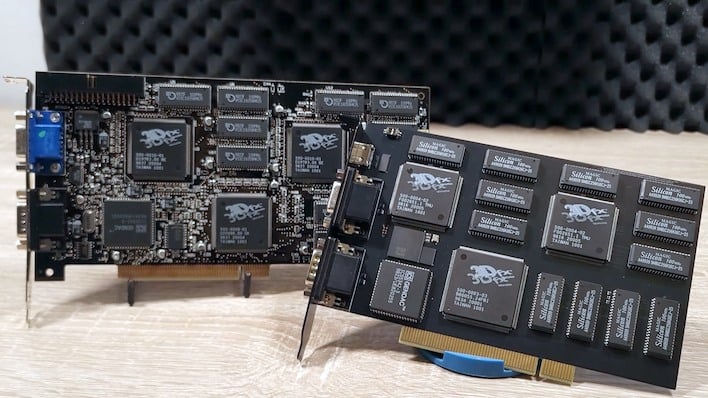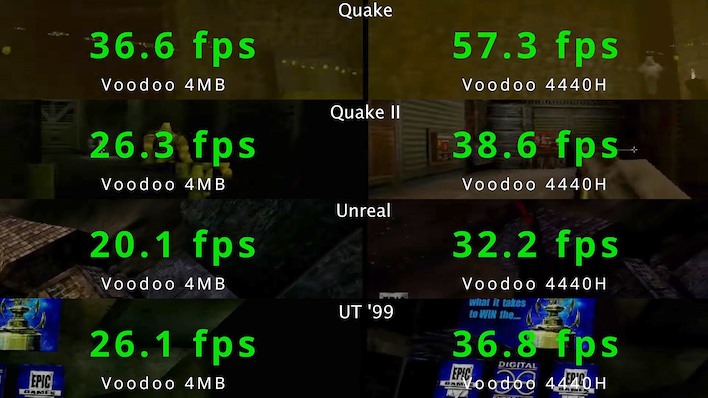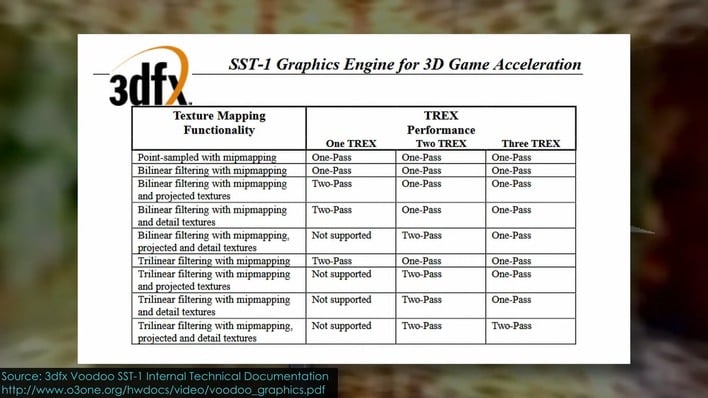3dfx Voodoo Card Modded With Extra Chips & VRAM Unleashes A Classic Gaming GPU
Yet, the Voodoo graphics cards that we all got back then barely scraped the surface of what the "SST" architecture was capable of. As explained and demonstrated in a new video from graphics-focused YouTuber PixelPipes, the original 3dfx Voodoo was a modular design from the start. This won't be a surprise to anyone who knows how these cards work, but the short version is that, unlike competitors, 3dfx split out the components of the render pipeline into separate chips: one chip, known as TREX internally, was the texture mapping unit, and one chip known as FBI was the frame buffer processor.
Doing this allowed the chips to be manufactured cheaply while having their own discrete 64-bit memory bus, solving an I/O problem where the Quad Flat packaging they were using had a limited amount of I/O. However, the connection between the FBI and TREX chips was designed as a scalable multi-point bus to begin with. This means that you can plop another TREX chip down with its own local memory bus and EDO DRAM and effectively double your texturing throughput. This was important as games started to make use of single-pass multi-texturing, as performance on the original Voodoo hardware could suffer due to only having one TMU.
This, in combination with a die shrink, is exactly what the Voodoo 2 was. The shrink to a 350-nanometer fabrication allowed 3dfx to clock the Voodoo 2 higher, but the main difference between the first-generation and second-generation Voodoo cards was the presence of the second TMU. There were actually Voodoo cards made this way before the Voodoo 2, but they were rare and primarily targeted at the professional 3D market by Quantum3D, which was founded in 1997 as a spin-off company by former 3dfx employees.

In the video, PixelPipes goes over a 3dfx Voodoo card with a fresh board design created by beloved 3dfx fanatic and modder sdz, whose work we've reported on before. This board design incorporates a single Voodoo FBI as well as two TMUs, and a total of 12MB of graphics memory—4MB for the FBI, and 4MB each for the TMUs. The clever among you will have realized that this essentially turns it into a Voodoo 2, except that it's using the older 500-nanometer (or "0.5 micron") chips and running at the Voodoo's 50MHz clock rate instead of the Voodoo 2's 90MHz.
It's important to explain that this isn't "SLI," exactly. The original 3dfx Voodoo SLI stood for "scanline interleave" and described the capability of two or more cards to synchronize with each other such that each Voodoo accelerator only had to draw a portion of the scan lines for a full picture. While the TMUs operated on scanlines, they did so in a serial fashion thanks to a bus that connected them directly.

PixelPipes tests the card and finds that it offers virtually no performance benefit when used in a period-correct Voodoo 1 system with an original Pentium processor. However, pairing it with a later Pentium II machine shows enormous performance gains—as much as 60% over the standard 4MB single-TMU Voodoo card. This demonstrates the foresight of the 3dfx team in understanding that very few people had PCs that could have taken advantage of the bigger card with the second TMU. By focusing on the one-FBI, one-TMU design, the company kept costs down and made the Voodoo accessible to PC gamers, which was critical to its success.
The YouTuber unfortunately doesn't compare the custom card against the Voodoo 2 or later cards, but that's probably because the "SDZ-4440H" (as it's known, calling back to the Quantum3D version of the same), as cool as it is, would ultimately get embarrassed by the newer accelerator with its 80% clock rate bump.
It's still a fascinating project, though, and even sdz himself was apparently blown away at the huge performance gains on tap. It makes sense, though; without that second TMU, you're having to burn extra clock cycles on texture mapping and texture filtering. With the extra chips, the TMU and its RAM, you can complete it all in a single pass, which frees up the FBI to move on to the next frame.
If you're interested at all, we recommend you to watch PixelPipes' video because he explains all of this with visual examples that make it very easy to understand. It's pretty long and the audio is kinda dubious at times because his lavalier mic failed on him, but still a very cool project from someone who is legitimately interested in the topic—not a disinterested dork smugly reading Wikipedia pages at you.


